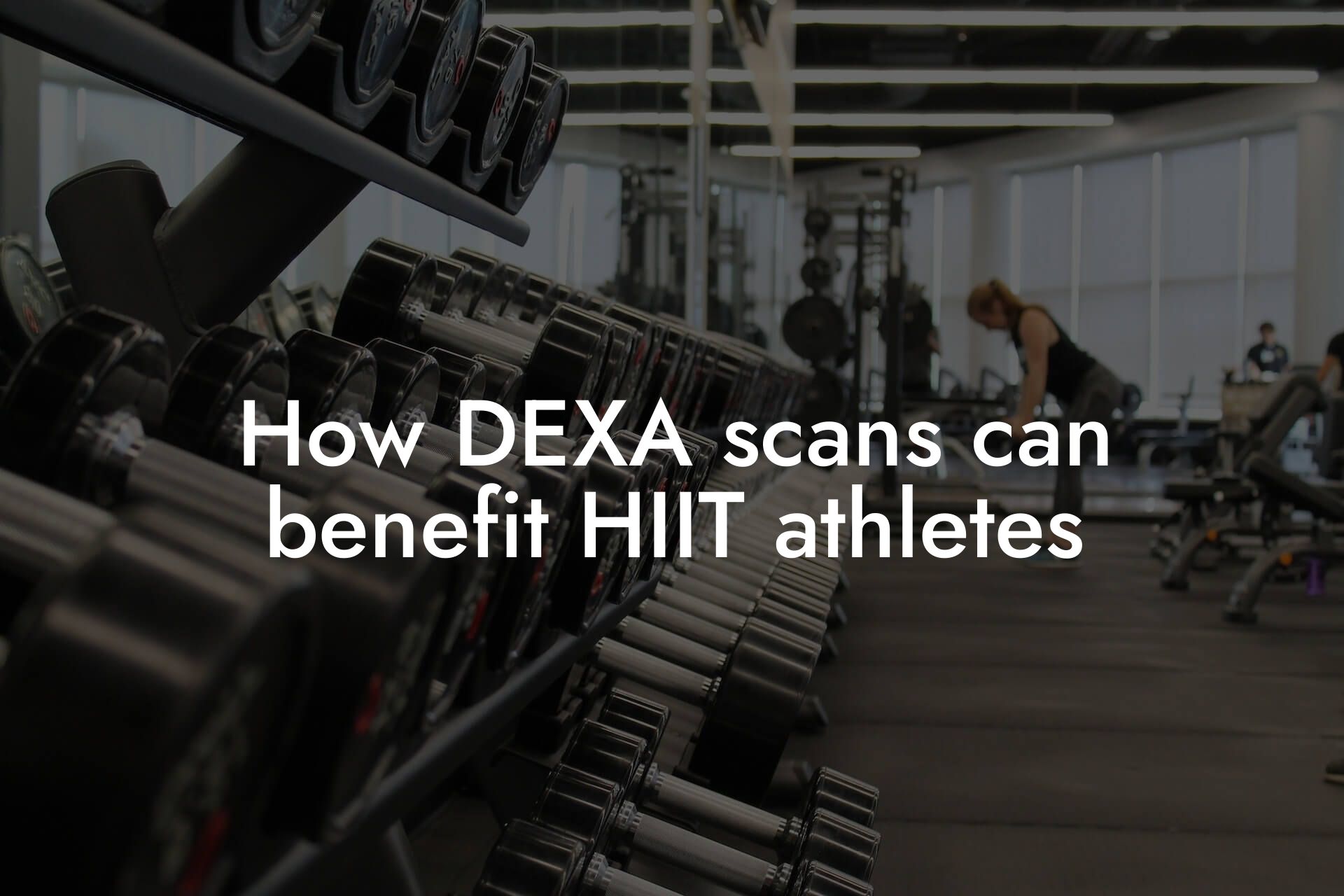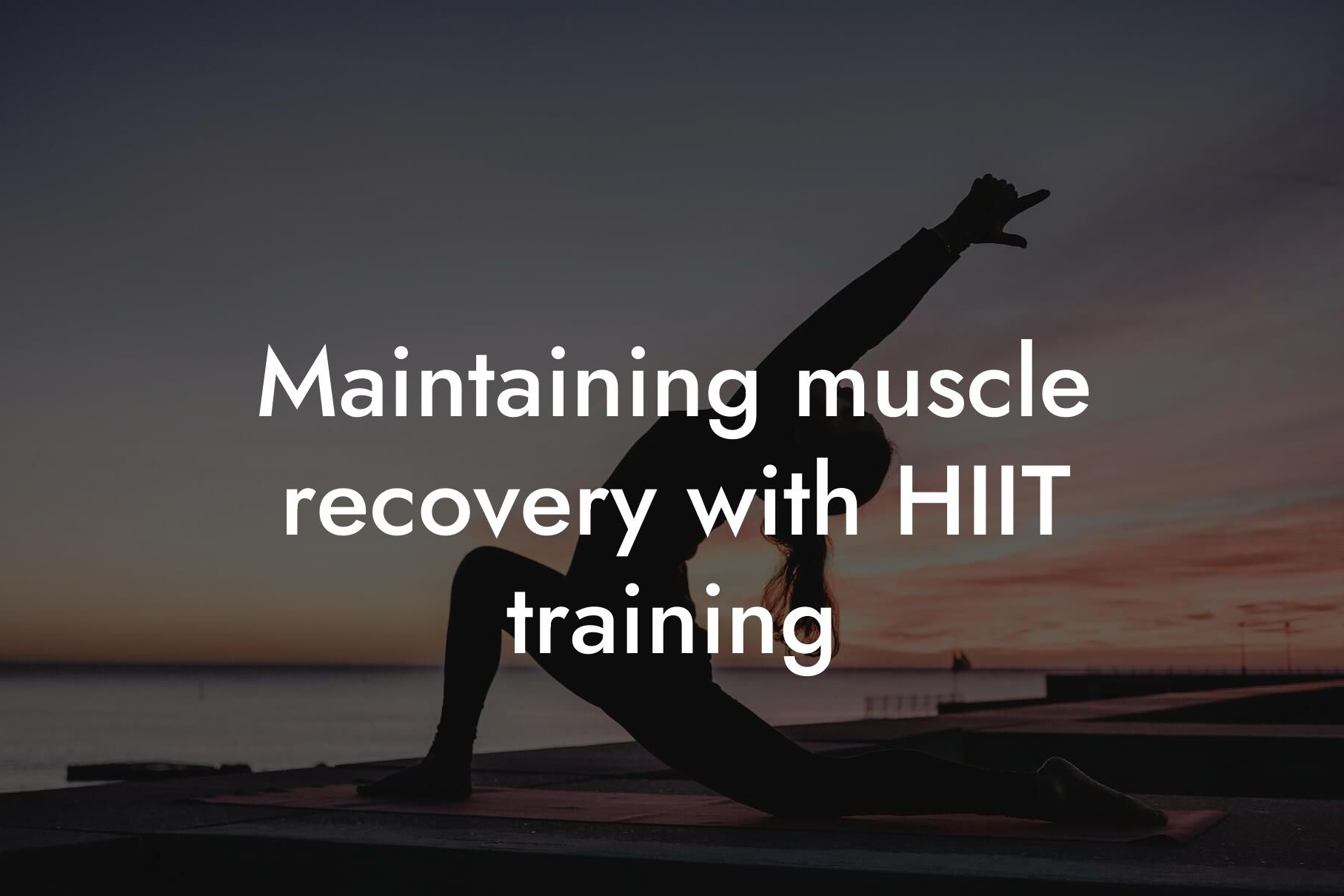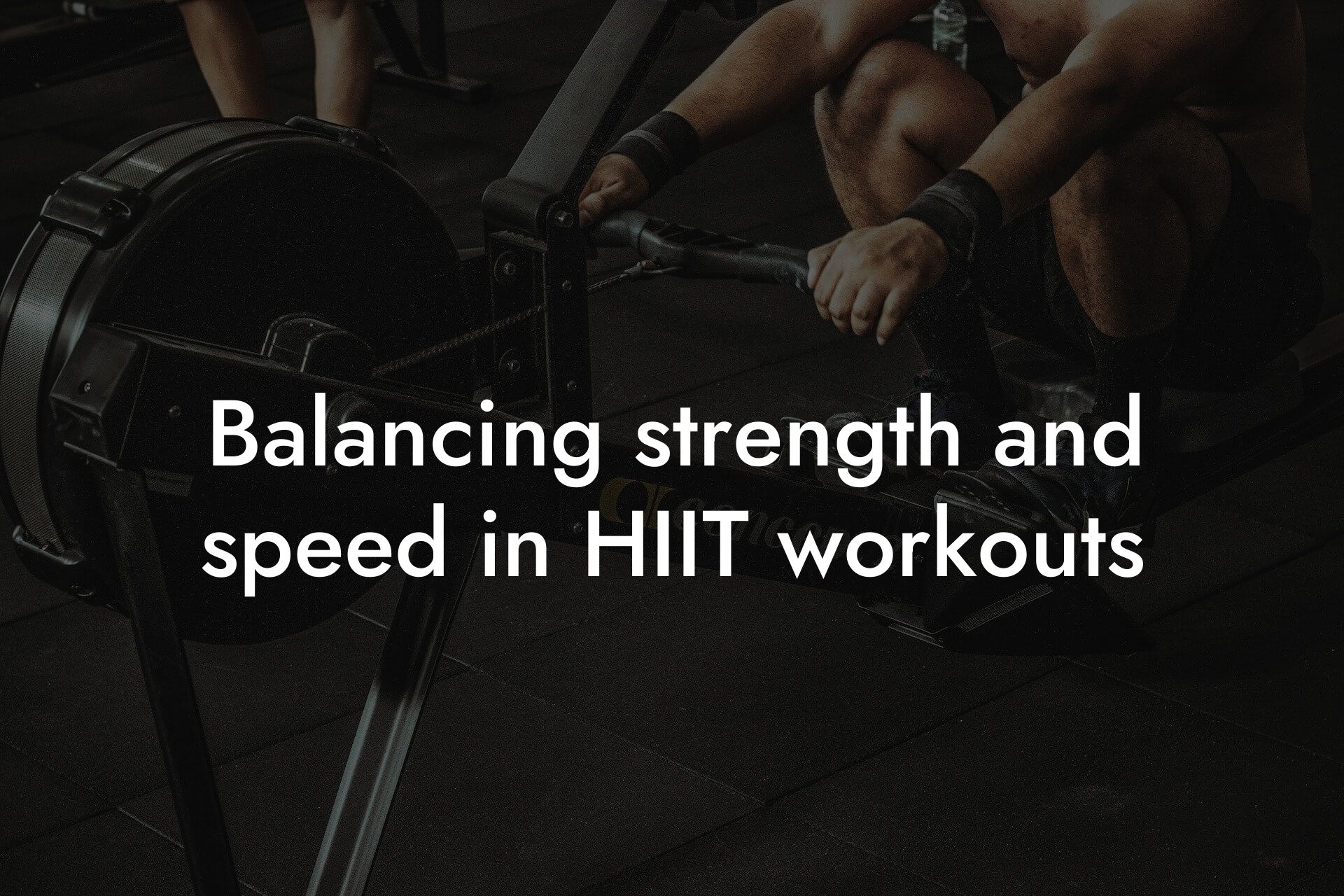High-Intensity Interval Training (HIIT) has become a popular workout method among fitness enthusiasts, including high-earning professionals, due to its time-efficient and effective way of improving cardiovascular health and burning calories. However, HIIT sessions can also increase the risk of injuries if not performed properly. As a professional interested in maintaining a healthy physique and body composition, it's essential to take preventive measures to avoid injuries and get the most out of your HIIT workouts.
Table of Contents
- Warm-up and Cool-down: The Foundation of Injury Prevention
- Choose the Right Exercises and Modifications
- Listen to Your Body: Rest and Recovery
- Proper Form and Technique
- Hydration and Nutrition
- Incorporate Injury-Prevention Exercises
- Use Proper Equipment and Gear
- Get Enough Sleep and Manage Stress
- Frequently Asked Questions
Warm-up and Cool-down: The Foundation of Injury Prevention
A proper warm-up and cool-down are crucial components of any workout routine, including HIIT. A warm-up prepares your muscles for the upcoming exercise, increases blood flow, and reduces the risk of muscle strains. A cool-down, on the other hand, helps your body recover from the intense exercise, reduces muscle soreness, and prevents dizziness. A typical warm-up and cool-down routine should include light cardio, stretching, and mobility exercises.
Choose the Right Exercises and Modifications
HIIT workouts often involve high-impact exercises like jump squats, box jumps, and burpees. While these exercises are effective for burning calories, they can be challenging for your joints and muscles. To prevent injuries, it's essential to choose exercises that suit your fitness level and modify them when necessary. For example, if you have knee issues, you can replace jump squats with step-ups or bodyweight squats. Additionally, focus on exercises that work multiple muscle groups at once, such as squats, lunges, and deadlifts, to reduce the overall number of exercises and minimize the risk of overuse injuries.
Listen to Your Body: Rest and Recovery
HIIT workouts are designed to push your body to its limits, but it's essential to listen to your body and take rest days when needed. Ignoring fatigue, pain, or discomfort can lead to injuries, and it's crucial to prioritize rest and recovery. Allocate at least one or two rest days per week, and engage in low-intensity activities like yoga, stretching, or light cardio to aid in recovery.
Proper Form and Technique
Proper form and technique are critical components of any exercise routine, including HIIT. Poor form can put unnecessary stress on your joints and muscles, leading to injuries. Focus on maintaining proper posture, engaging your core, and using the correct muscle groups for each exercise. If you're new to HIIT or unsure about proper form, consider working with a personal trainer or fitness coach who can provide guidance and feedback.
Hydration and Nutrition
Proper hydration and nutrition are essential for optimal performance and injury prevention during HIIT workouts. Aim to drink at least 8-10 glasses of water per day, and make sure to consume a balanced meal or snack with a mix of protein, complex carbohydrates, and healthy fats 1-2 hours before your workout. Additionally, consider adding electrolyte-rich foods or supplements to your diet to prevent dehydration and muscle cramps.
Incorporate Injury-Prevention Exercises
In addition to your regular HIIT workout, incorporate exercises that target your core, glutes, and legs, such as planks, side planks, and leg raises. These exercises can help improve your overall stability, balance, and strength, reducing the risk of injuries during HIIT sessions.
Use Proper Equipment and Gear
Using proper equipment and gear can help prevent injuries during HIIT workouts. Invest in a good pair of shoes with adequate support and cushioning, and consider using a jump rope, resistance bands, or a medicine ball to add variety to your workouts. Additionally, make sure to use a clean and safe workout environment, free from obstacles and hazards.
Get Enough Sleep and Manage Stress
Sleep and stress management are critical components of overall health and fitness, including injury prevention during HIIT workouts. Aim to get at least 7-9 hours of sleep per night, and engage in stress-reducing activities like meditation, yoga, or deep breathing exercises. Poor sleep and high stress levels can increase the risk of injuries, so prioritize these aspects of your overall health and wellness.
By following these guidelines and taking a proactive approach to injury prevention, you can minimize the risk of injuries during HIIT sessions and achieve your fitness goals. Remember to stay hydrated, listen to your body, and prioritize rest and recovery to get the most out of your workouts. At Tano Performance Group, we're committed to helping high-earning professionals like you achieve optimal physical performance and body composition. Contact us today to learn more about our comprehensive body assessment services using DEXA technology.
Frequently Asked Questions
What is HIIT and why is it popular among high-earning professionals?
HIIT stands for High-Intensity Interval Training, a type of workout that involves short bursts of high-intensity exercise followed by brief periods of rest. It's popular among high-earning professionals because it's an efficient way to improve cardiovascular health, increase strength and endurance, and boost metabolism, all while fitting into a busy schedule.
What are the benefits of incorporating HIIT into my fitness routine?
HIIT offers numerous benefits, including improved cardiovascular health, increased caloric burn, enhanced muscular endurance, and improved insulin sensitivity. It can also help reduce body fat, improve mental clarity, and boost energy levels.
What are the most common injuries associated with HIIT?
The most common injuries associated with HIIT include muscle strains, shin splints, knee injuries, and lower back strains. These injuries often occur due to improper form, overexertion, or inadequate warm-up and cool-down routines.
How can I prevent injuries during HIIT sessions?
To prevent injuries during HIIT sessions, it's essential to warm up properly, cool down after exercise, listen to your body and take regular breaks, focus on proper form and technique, and incorporate strength training exercises to improve overall muscle resilience.
What is the importance of proper warm-up and cool-down routines in HIIT?
A proper warm-up prepares your muscles for intense exercise, reducing the risk of injury, while a cool-down helps your body recover and reduce muscle soreness. A good warm-up should include light cardio and dynamic stretching, while a cool-down should involve static stretching and foam rolling.
How can I improve my flexibility and range of motion to reduce the risk of injury during HIIT?
Regular stretching exercises, both static and dynamic, can help improve flexibility and range of motion. It's also essential to incorporate exercises that target specific muscle groups, such as hip flexors and calves, which are prone to tightness.
What is the role of strength training in preventing HIIT injuries?
Strength training helps improve muscle resilience, reducing the risk of injury during HIIT. Focus on exercises that target your core, glutes, and legs, as these are the primary muscle groups used during HIIT.
How can I listen to my body and avoid overexertion during HIIT?
Listen to your body by paying attention to signs of fatigue, pain, or discomfort. If you experience any of these symptoms, stop immediately and rest. It's also essential to start with moderate intensities and gradually increase as your body adapts.
What are some common mistakes to avoid during HIIT sessions?
Common mistakes to avoid during HIIT include poor form and technique, inadequate warm-up and cool-down, overexertion, and ignoring signs of fatigue or pain. It's also essential to avoid exercising on an empty stomach or without proper hydration.
How can I modify HIIT exercises to accommodate my fitness level?
Modify HIIT exercises by reducing intensity, duration, or frequency. You can also substitute exercises with lower-impact alternatives or incorporate rest days to allow your body to recover.
What is the importance of proper footwear and attire during HIIT?
Proper footwear and attire can help reduce the risk of injury by providing support and comfort. Choose shoes with good arch support and cushioning, and wear breathable, moisture-wicking clothing that allows for a full range of motion.
How can I stay hydrated during HIIT sessions?
Stay hydrated by drinking water or a sports drink before, during, and after exercise. Aim to drink at least 8-10 glasses of water per day, and consider incorporating electrolyte-rich foods or supplements to replenish lost electrolytes.
What role does nutrition play in preventing HIIT injuries?
Nutrition plays a crucial role in preventing HIIT injuries by providing your body with the necessary fuel for exercise. Focus on a balanced diet that includes lean protein, complex carbohydrates, and healthy fats, and avoid consuming heavy meals before exercise.
How can I recover from a HIIT injury?
Recover from a HIIT injury by resting and avoiding activities that exacerbate the injury. Apply the RICE principle (rest, ice, compression, and elevation), and consider incorporating physical therapy or massage to aid in recovery.
What are some common myths about HIIT and injury prevention?
Common myths about HIIT and injury prevention include the idea that HIIT is only for young people, that you need to be extremely fit to start HIIT, or that HIIT is inherently dangerous. These myths are debunked by the numerous benefits and safety precautions associated with HIIT.
How can I incorporate HIIT into my busy schedule?
Incorporate HIIT into your busy schedule by finding a workout routine that fits your lifestyle, such as early morning or lunch break sessions. You can also try HIIT at home or in a gym, or incorporate HIIT exercises into your daily activities, such as taking the stairs instead of the elevator.
What are some benefits of working with a personal trainer or fitness coach during HIIT?
Working with a personal trainer or fitness coach during HIIT can provide personalized guidance, correct form and technique, and help you stay motivated and accountable. They can also help you modify exercises to accommodate your fitness level and goals.
How can I track my progress and stay motivated during HIIT?
Track your progress by setting specific, measurable goals, and monitoring your progress through metrics such as weight, body fat percentage, or workout completion. Stay motivated by finding a workout buddy, rewarding yourself for milestones achieved, and celebrating small victories.
What are some common misconceptions about HIIT and weight loss?
Common misconceptions about HIIT and weight loss include the idea that HIIT is only for weight loss, that HIIT is a quick fix, or that HIIT is only effective for short-term weight loss. In reality, HIIT can be an effective tool for sustainable weight loss and overall fitness.
How can I incorporate HIIT into my overall fitness routine?
Incorporate HIIT into your overall fitness routine by combining it with other forms of exercise, such as strength training, yoga, or cardio. Aim to do HIIT 2-3 times per week, and incorporate rest days or active recovery days to allow your body to recover.
What are some tips for staying safe during outdoor HIIT sessions?
Stay safe during outdoor HIIT sessions by choosing a safe location, avoiding exercising in extreme weather conditions, wearing reflective clothing or accessories, and staying hydrated. It's also essential to be aware of your surroundings and avoid exercising alone in isolated areas.
How can I make HIIT more enjoyable and engaging?
Make HIIT more enjoyable and engaging by finding a workout buddy, trying new exercises or routines, incorporating music or podcasts, and rewarding yourself for milestones achieved. You can also try HIIT in different environments, such as outdoors or in a group fitness class.
What are some common mistakes to avoid when starting a HIIT program?
Common mistakes to avoid when starting a HIIT program include starting too intensely, not warming up or cooling down properly, and ignoring signs of fatigue or pain. It's also essential to set realistic goals and expectations, and to consult with a healthcare professional before starting any new exercise program.
Here are some related articles you might love...
- How DEXA scans can benefit HIIT athletes
- Maintaining muscle recovery with HIIT training
- Balancing strength and speed in HIIT workouts
- Improving cardiovascular endurance with HIIT
- The role of body composition in HIIT performance
- The importance of bone density in HIIT fitness
- Strength training tips to enhance HIIT performance
- Reducing body fat for better HIIT workout results
- Nutrition strategies for HIIT enthusiasts
Zak Faulkner
Zak Faulkner is a leading authority in the realm of physical health and body composition analysis, with over 15 years of experience helping professionals optimise their fitness and well-being. As one the experts behind Tano Performance Group, Zak has dedicated his career to providing in-depth, science-backed insights that empower clients to elevate their physical performance and overall health.
With extensive knowledge of DEXA technology, Zak specializes in delivering comprehensive body assessments that offer precise data on body fat, muscle mass, bone density, and overall physique. His expertise enables individuals to make informed decisions and achieve their fitness goals with accuracy and confidence. Zak’s approach is rooted in a deep understanding of human physiology, combined with a passion for helping clients unlock their full potential through personalised strategies.
Over the years, Zak has earned a reputation for his commitment to excellence, precision, and client-focused service. His guidance is trusted by top professionals who demand the best when it comes to their health. Whether advising on fitness programs, nutritional strategies, or long-term wellness plans, Zak Faulkner’s insights are a valuable resource for anyone serious about taking their health and fitness to the next level.
At Tano Performance Group, Zak continues to lead our Content Team revolutionising how professionals approach their physical health, offering unparalleled expertise that drives real results.




